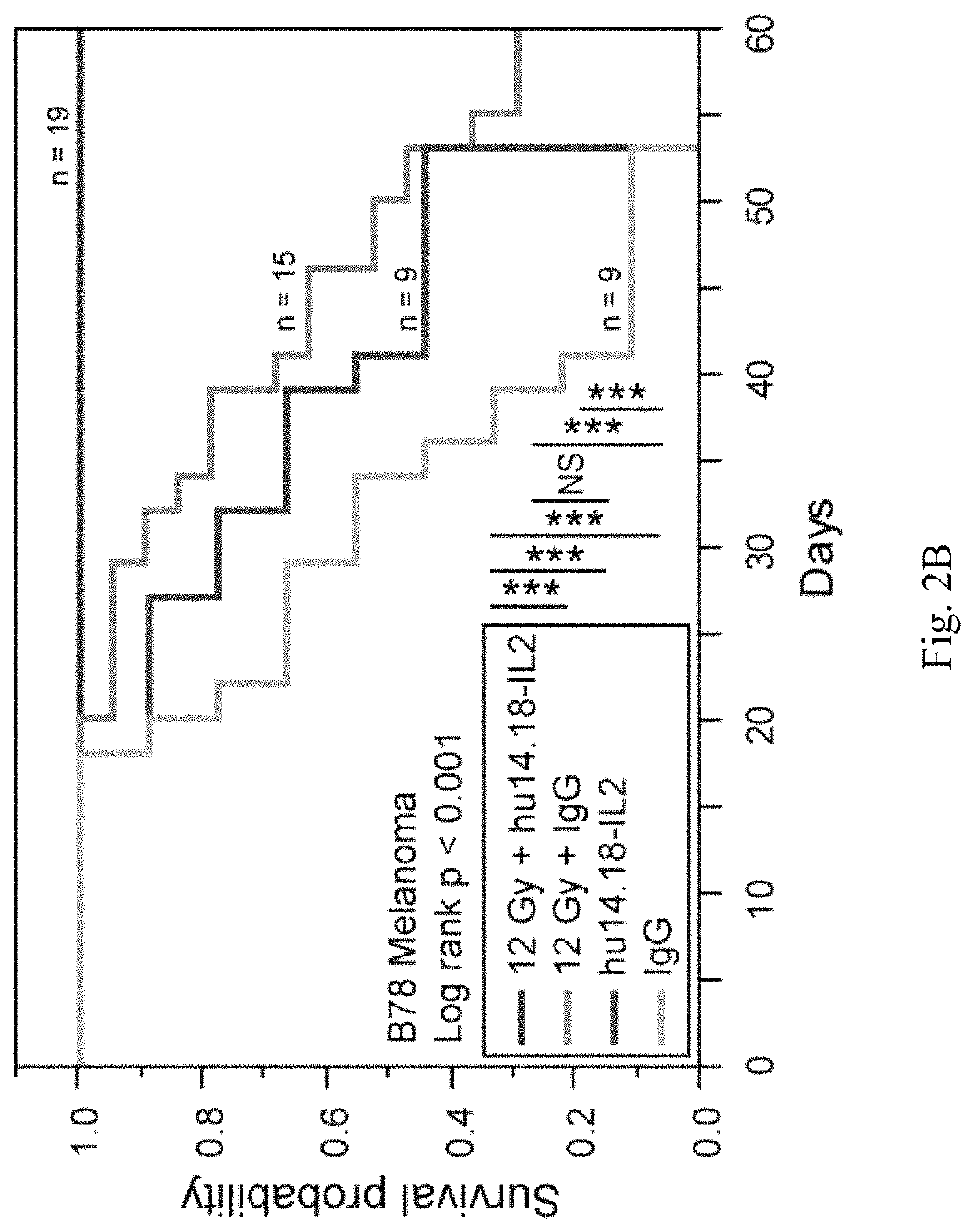Targeted radiotherapy chelates for in situ immune modulated cancer vaccination
a cancer vaccine and radiotherapy chelate technology, applied in immunological disorders, antibody medical ingredients, peptide/protein ingredients, etc., can solve the problems of limited tumor uptake and off-target toxicity, and achieve better imaging characteristics, high potential as rt agents, and improved imaging properties
- Summary
- Abstract
- Description
- Claims
- Application Information
AI Technical Summary
Benefits of technology
Problems solved by technology
Method used
Image
Examples
example 1
d Supporting Data
[0158]The Sondel lab has shown that tumor-specific mAb+IL2 activates innate immune cells to mediate ADCC in mice [2], with clinical benefit for children with neuroblastoma [3]. In mice, IV administration of the hu14.18-IL2 is more potent than IV administration of anti-GD2 mAb+IL2 [2, 10]. This can provide dramatic antitumor effects against very small recently established GD2+ tumors or very small microscopic metastases, potentially accounting for the clinical use of this approach in patients in remission but at great risk for relapse [3]. More potent antitumor efficacy against measurable, macroscopic tumors [i.e. ˜50 mm3 GD2+ tumors] can be achieved when the IC is injected intratumorally (IT-IC) rather than IV [4,5].
[0159]We are now focusing on ways to provide benefit in the setting of much larger, macroscopic tumors. Mice bearing a moderately large (200 mm3) B78 melanoma tumor, established five weeks earlier, show no response to IV-IC, and are slowed in their growt...
example 2
ng Dosages of xRT
[0164]Our data suggest these four hypotheses: (1) the dose of xRT we have used to treat a single tumor causes modest direct in vivo tumor death and increases susceptibility to immune mediated death (via both ADCC and T cells); (2) the strong T-cell response provided by the addition of IT-IC, but not IT mAb, suggests that mAb binding to radiated tumor cells, in the presence of IL2, facilitates antigen presentation and augmented induction of adaptive immunity; (3) the presence of a second tumor prevents the xRT+IT-IC to the first tumor from causing virtually any anti-tumor effect, due to tolerance caused largely by the systemic actions of immunosuppressive cells present in the second tumor [such as Tregs and possibly myeloid derived suppressor cells (MDSC)]; this tolerance can be circumvented by depletion of Tregs (FIG. 4) or irradiating the second tumor (FIG. 3); (4) the dose of RT needed at the second tumor to circumvent tolerance might be much lower than the xRT do...
example 3
Determining Dosage of 131I-NM404 and Evaluating Effects on Immune Function Dosimetry with TRT and Immunosuppression from TRT in C57BL / 6 Mice.
[0175]131I-NM404 has shown selective uptake in vitro in >95% of tumor lines (human and mouse), with poor uptake by non-malignant cells, and with similar tumor specificity seen in vivo. This includes selective uptake in vivo with the B78 tumor (FIG. 5). In our preliminary dosimetry study, we gave 124I-NM404 to C57BL / 6 mice and characterized the time course of TRT exposure by serial PET / CT imaging (as in FIG. 5). Monte Carlo dosimetry calculations [16-18] based on this study indicated that ˜60 μCi of 131I-NM404 would be needed to deliver ˜3 Gy to an established B78 tumor over a four week period of decay. After those four weeks, the remaining TRT dose to the B78 tumor would be less than 0.25 Gy. We will replicate the data we obtained in our 2-tumor model using xRT (FIG. 3), but use the lowest possible dose of targeted 131I-NM404 TRT to enable effe...
PUM
| Property | Measurement | Unit |
|---|---|---|
| half life | aaaaa | aaaaa |
| half life | aaaaa | aaaaa |
| half life | aaaaa | aaaaa |
Abstract
Description
Claims
Application Information
 Login to View More
Login to View More - R&D
- Intellectual Property
- Life Sciences
- Materials
- Tech Scout
- Unparalleled Data Quality
- Higher Quality Content
- 60% Fewer Hallucinations
Browse by: Latest US Patents, China's latest patents, Technical Efficacy Thesaurus, Application Domain, Technology Topic, Popular Technical Reports.
© 2025 PatSnap. All rights reserved.Legal|Privacy policy|Modern Slavery Act Transparency Statement|Sitemap|About US| Contact US: help@patsnap.com



